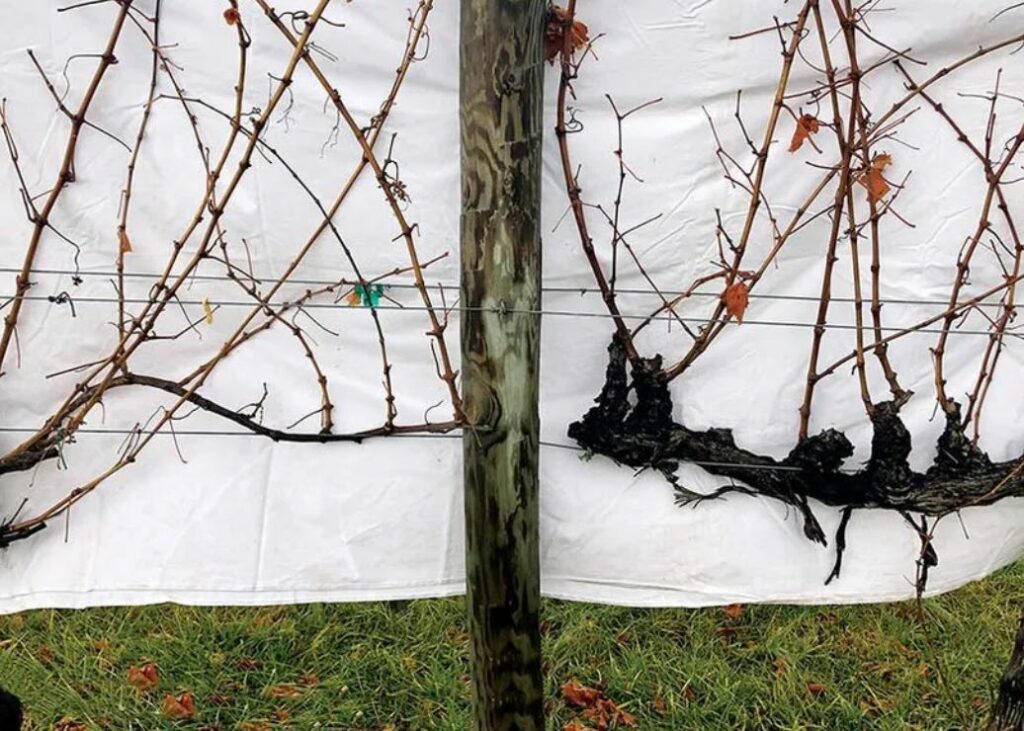Dormant Cane and Spur Pruning (PennState Extension)

Introduction
Grapevine pruning is an important and labor-intensive vineyard management task. Grapevine buds contain compressed shoots that will grow and produce a crop in the forthcoming season. Retaining fruitful buds is the primary method of manipulating shoot density and cluster number for the following season. When pruning, it’s important to cut away and discard one-year-old wood and to select and retain specific buds for the following season.
The results of ineffective or incomplete dormant pruning are excessive shoot density and a congested canopy that impairs airflow and light penetration, creating a greater susceptibility to fungal disease. Failing to prune out infected tissues will increase the incidence of woodborne diseases and limit vineyard productivity over time. In the short term, ineffective dormant pruning will compromise crop quantity and quality. In the long term, it will compromise vineyard health and sustainability. This publication contains a basic discussion of commercially important pruning strategies and considerations for bunch grapes in the eastern United States.
When to Prune
It is necessary to prune every year. Pruning should occur later in the dormant season and before budbreak (Figure 1). The dormant season typically spans from November through April in the eastern United States. Deciding when to start pruning often depends on vineyard acreage and available labor. Vineyards with low labor-to-acreage ratios (few hands, many acres) may start pruning in December, while vineyards with high labor-to-acreage ratios (many hands, few acres) may wait until March. However, pruning in the fall is less desirable than in the late winter or early spring due to the increased chance of cold injury (Reynolds and Wolf 2008).
If labor is limited and pruning must begin earlier, cultivars that have greater cold hardiness or more fruitful secondary buds (e.g., several hybrids) should be pruned before those that are less cold hardy and have less fruitful secondary buds (e.g., several Vitis vinifera cultivars). See Dami (2007) for a table of relative cold hardiness across grape genotypes. Postpone pruning until colder temperatures are less of a threat to allow for cold injury assessment and to adjust for bud number retention. Regardless of when pruning starts, the goal should be to finish before budbreak.
What to Prune
The goal of pruning in the first two years after planting is to establish the permanent vine structures (e.g., trunks, cordons) and shape the vine to accommodate the intended training system. In young vineyards, the woody canes to be retained as trunks and other permanent portions of the grapevine should be roughly 3/8 inch in diameter. New grape growers commonly fail to prune off enough wood in the first two years after vine establishment. When wood is less than 3/8 inch in diameter, growers should prune vines aggressively so that retained buds will produce larger shoots to develop as trunks and cordons the following year. After permanent vine structures have been established, pruning is implemented on one-year-old (if spur pruning) and two-year-old (if cane pruning) tissues to maintain crop yield and canopy architecture.
Shoots are the vegetative green tissues produced from a grapevine bud. Grapevine shoots grow and mature into canes (woody tissues) over the course of a growing season. When dormant pruning, the pruner should retain the desired grapevine buds from canes. Desirable canes are from 3 to 5 feet in length, 1/3 to 3/8 inch in diameter (slightly larger than the diameter of a pencil), and have had ample sunlight exposure in previous seasons (resulting in a brown/cinnamon color). Canes larger or smaller than this size range are less desirable for retention at dormant pruning. Thin, dried, dead, and hollowed-out “straw canes” should not be retained. Larger canes (commonly called “bull canes”) may contain buds that produce shoots with lower cluster numbers and/or reduced cold tolerance. Canes that were vigorous growers in the previous season often have longer internodes (space between buds; see below) and fewer buds per cane length; thus, vigorous vines may result in difficulty retaining the desired bud number within a confined fruit zone.
Nodes are the swollen, thick sections of shoots and canes. The internode is the slimmer section between nodes. Buds are located at the nodes and contain the compressed shoots that have not yet emerged (see Figure 1). It is important to distinguish “count” versus “noncount” buds when selecting buds to retain and forecasting crop potential. Count and noncount buds can be distinguished by evaluating their position on the spur, which is the retained portion of a cane typically containing one to three buds (Figure 2). Buds are numbered in ascending order starting at the base of the cane/spur (e.g., noncount bud, count bud 1, count bud 2). Bud fruitfulness differs among cultivars. Noncount basal buds are not often fruitful on Vitis vinifera cultivars (e.g., ‘Cabernet Sauvignon’), which means the shoot that develops from a noncount bud is unlikely to bear clusters. Many hybrid cultivars (e.g., ‘Seyval blanc’ and ‘Vidal blanc’) contain fruitful noncount buds, meaning the shoot developing from the noncount bud will often produce clusters.

